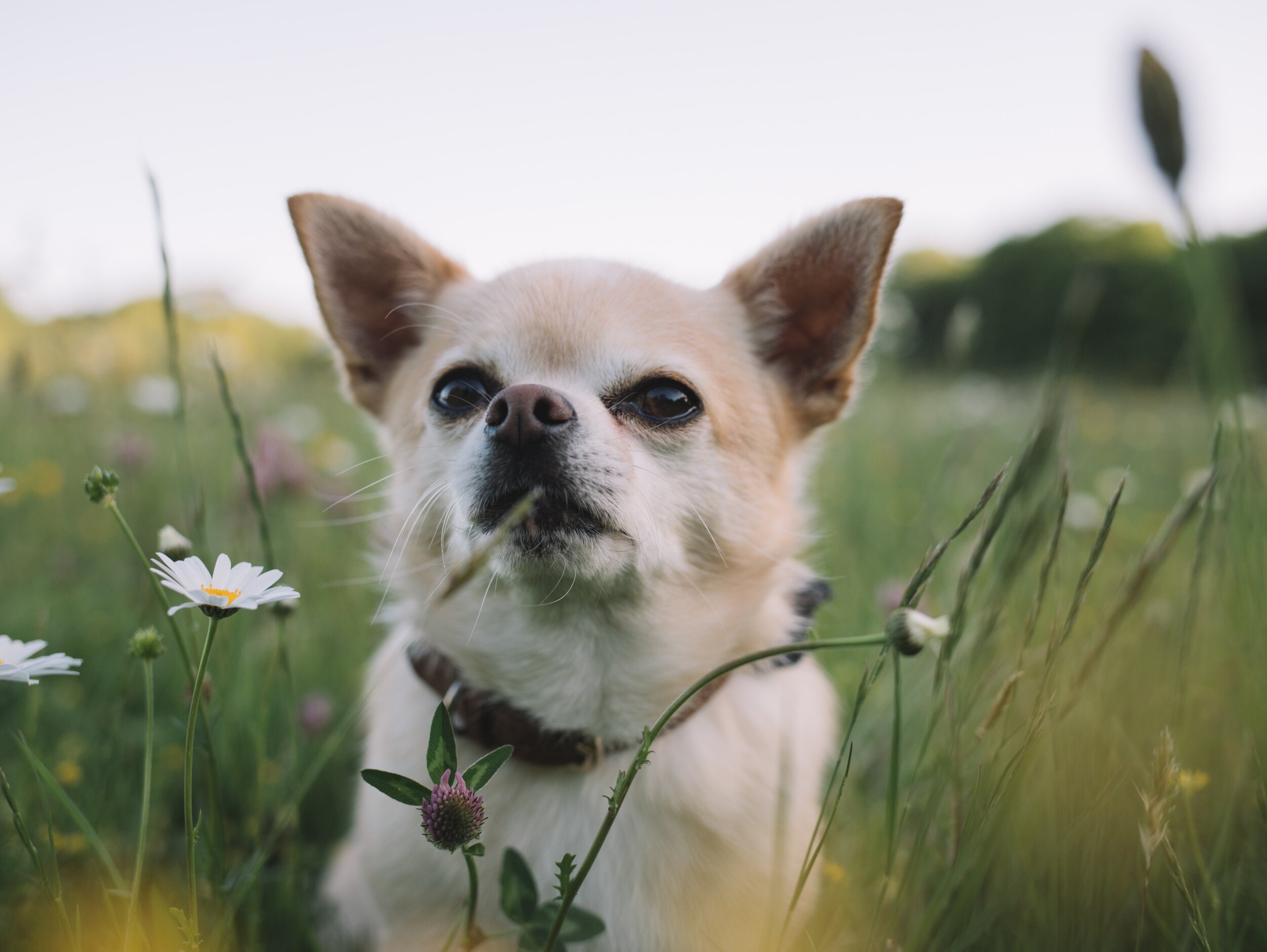
Fiona the Chihuahua
The Case:
Fiona the 1-year-old Chihuahua was a serial barker. She and her owners lived in an apartment and Fiona was always barking as neighbors walked by the front door! This could happen at all times of the day and her owners found this both startling & unpleasant! Fiona, too, seemed to be very upset whenever she heard a neighbor and always took a while to settle down after an episode. Her owners would like Fiona to bark less often.
To change this response, we have a 4 step solution to implement:
Understand What’s Causing the Behavior.
Prevention.
Training Sessions.
Real Life Occurrences.
Understand What’s Causing the Behavior:
Barking is one of several ways dogs communicate with us! What they are trying to say can vary a lot and we need to look at what type of situation they are in, the type of bark, and what else they do in that situation to help us understand what they are trying to say. In this case, Fiona is alert barking when she hears a change in the environment- a person outside! She has no way to know if that person is a welcomed guest or an intruder, but she knows for sure it’s important news that someone is here and her instincts tell her she has to at least say something.
Fiona probably is also frustrated at the fact that her humans never seem to take these potential threats seriously! She always has to be the first one to speak up when there’s a noise outside- can you imagine the stress of being the only one in your family who wards off intruders, night & day? Nobody ever even helps her! Her work never ends and she often spends day after day on edge trying to keep everybody safe.
Last but not least, we need to check over Fiona’s basic needs to ensure an unmet need is not exacerbating the barking problem or going to slow down the training process. Basic needs are things like:
Health: Fiona has had a checkup with her veterinarian in the last 6 months and is displaying no signs of pain or illness. We’re good to go!
Nutrition: Fiona likes her nutritionally complete freeze-dried food & eats it all at mealtime. She is also a fiend for treats! No problems found here.
Sleep: Fiona is getting around 10 hours of sleep a day. Uh-oh! An adult dog should be getting around 12-14 hours of sleep a day, and an adolescent (read: teenage) dog should be getting more. A sleep-deprived dog is a grumpy dog who will be more easily pushed to bark when they hear strange noises. We adjust Fiona’s daily schedule to feature some naptime in a quiet area away from the front door.
Exercise: Fiona is getting two 30-minute walks every day and plays tug indoors most days. Perfect!
Enrichment: Fiona’s parents had never heard this word before our consultation! It’s short for mental exercise and is all about problem-solving & experiencing new things and situations. Fiona’s life is pretty routine and she gets to lay around the house most days- this is a little too boring, especially for a young dog! Bored dogs will often seek out and create their own job, like- you guessed it! Guarding the apartment. Adding in some food puzzle toys, a how-to book for teaching Fiona some fun tricks, and some designated sniffy time during her morning walk will help her feel accomplished and not so restless.
Prevention:
For the fastest results, we need to make sure Fiona doesn’t have the opportunity to practice excessive barking. To do this, we need to change the environment to reduce the amount of noise Fiona can hear, especially while nobody is home to manage the situation. Her owners invest in soundproof weather stripping and a white noise machine by the front door. Fiona likes her crate, so when she is left alone in the apartment they crate her in the bedroom far away from the front door. All this prevents Fiona from practicing excessive barking and lets everyone in the house, Fiona included, take a break from all that stressful noise! Now only the loudest of noises can be heard from inside the apartment.
Training Sessions:
First things first is to create a list of the noises that trigger Fiona to bark:
Footsteps
Voices
Other Dogs Barking
Now that we have our list, it’s time to start training! Sessions should be short, frequent, fun & filled with success!
We start by making the noises while inside the house at a lower volume than usual so that Fiona isn’t as tempted to bark. First we will do this exercise while standing next to her, then while standing next to the front door. While one person is making the noises, the other person is feeding Fiona a treat and praising her in a quiet, calm voice whenever they hear a noise outside. Over time, we raise the volume of the triggering noises until they’re at whatever volume we need Fiona to be able to handle hearing.
Next, we take the noises outside into the hallway! Whenever a household member is on the way home, they let whoever is already home know to get ready for a training session. In the hallway, the person coming home is going to be making the trigger noises just like in the first exercise. Starting at a low volume and slowly increasing the volume over several session. Inside, the person who is home is also doing exactly what they were doing during the last exercise: treating & praising Fiona as soon as they hear the person outside.
Real Life Occurrences:
Our goal is to praise Fiona calmly before she begins barking whenever an unexpected noise happens. For the first few weeks we are also going to give her a treat every time this happens! This cements in her new positive association with noises and can be weaned off of over time.
If we miss our opportunity and Fiona begins barking, we are going to get up and go over to her and ask for her to look at us to interrupt the behavior. We then reward her for looking at us and redirect her to go get a toy or a chew laying around and go settle onto her bed, which is away from the front door. This gives Fiona a coping behavior that helps her settle down when unexpected noises startle her.
After a few weeks of training Fiona will relearn how to deal with hearing scary noises outside. Once Fiona learns to usually stay calm & quiet after hearing noises, we continue to do everything for a few more weeks to help ensure the training sticks! Only then can we begin to wean off of management tools like the white noise machine, teaching tools like the training sessions, and go from rewarding her with a treat after every surprise noise to just the louder and more startling ones. If she regresses, we know she needs us to continue to help her by using that tool still. We plan to always continue to reinforce Fiona getting a toy or a chew and settling down onto her bed after hearing a scary noise as our ultimate goal is to have Fiona learn to manage her own behavior.

